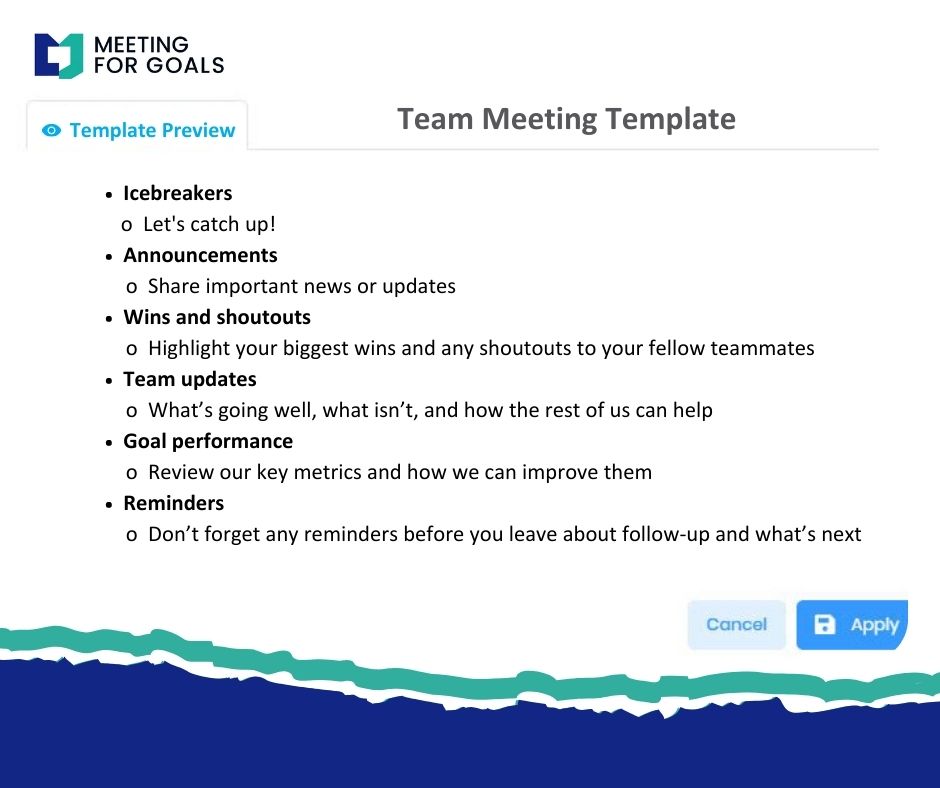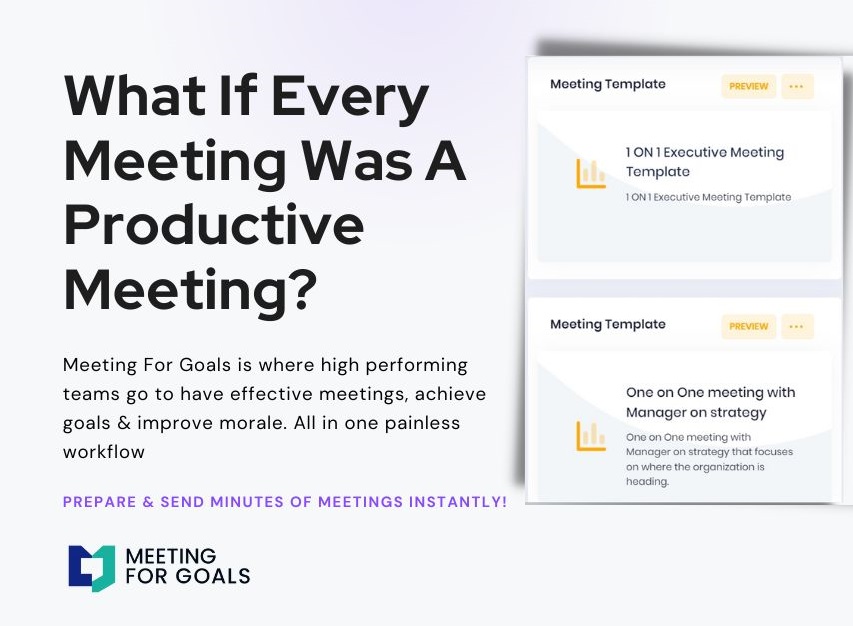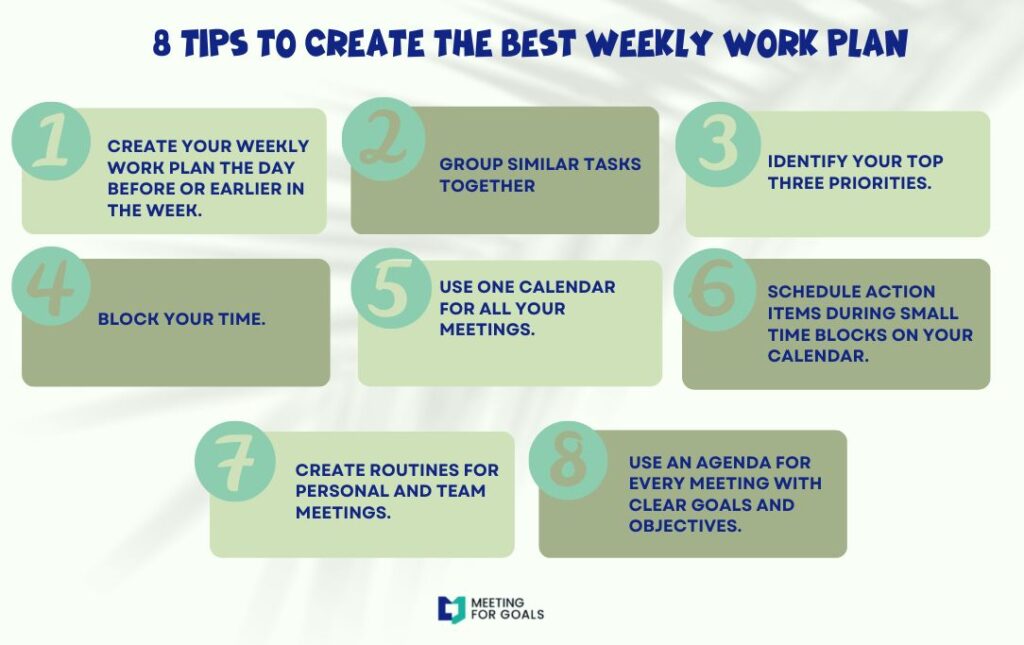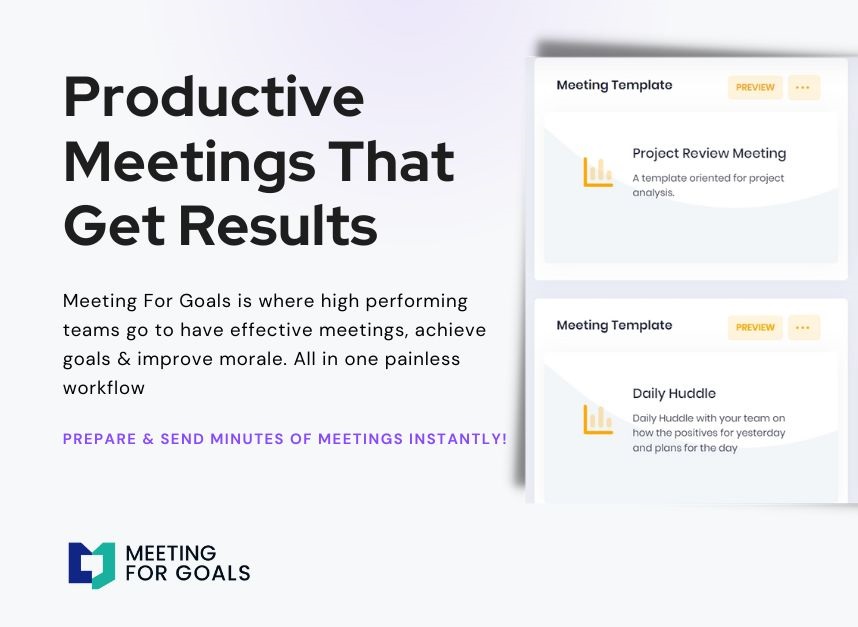Mastering Board of Directors Meetings: A Strategic Guide to Productive Leadership Sessions
Board of Directors meetings are the cornerstone of strategic decision-making and organizational governance. Yet, many companies struggle with unproductive discussions, unclear outcomes, and wasted time. In this comprehensive guide, we’ll walk you through how to master board meetings—from preparation to follow-up—using modern tools like Meeting For Goals. Whether you’re a Director, VP, or C-suite executive at a mid-sized company, this blog will empower you to streamline your meetings, align your leadership team, and drive results.
I. Introduction
Board of Directors meetings aren’t just routine checkpoints—they’re where big decisions happen. These sessions bring together top leadership to:
- Assess progress
- Tackle challenges
- Chart the company’s future
For companies with 40 to 70 employees, where agility and alignment are crucial, the quality of board meetings can make or break momentum.
Unfortunately, many organizations find their board meetings falling short. They’re often bogged down by:
- Vague agendas
- Unclear roles
- Lengthy discussions that go nowhere
That’s where Meeting For Goals steps in. At Meeting For Goals, we believe meetings should move your business forward—not waste time. Our meeting management software helps executive teams:
- Prepare better
- Run more focused meetings
- Follow up with ease
The result? Shorter, smarter, more impactful board meetings.
If you’re ready to take your board meetings to the next level, start by exploring our free meeting templates or sign up now to experience the full power of Meeting For Goals.
In this guide, we’ll break down the six essential components to mastering board meetings:
- Understanding the structure of a board meeting
- Pre-meeting preparation
- Facilitating effective discussions
- Post-meeting follow-up
- Leveraging technology to streamline the process
- Final strategies for long-term success
Let’s get started.
2 Minute Video
Watch a 2 minute demo of our meeting management software in action
II. Understanding the Structure of a Board Meeting
Before you can improve your board meetings, you need to understand what makes them tick. A well-structured meeting provides clarity, consistency, and direction.
A. Key Components and Typical Agenda Items
Every board meeting should follow a clear roadmap. Here are the must-have agenda items:
- Call to Order – Officially opens the meeting and confirms a quorum is present.
- Approval of Previous Meeting Minutes – Ensures continuity and accountability.
- Financial Reports – Provides a snapshot of financial health and performance.
- Strategic Discussions – The core of the meeting, where big-picture decisions are made.
- Review of Action Items – Tracks progress and reinforces accountability.
These sections give structure to your meeting and ensure that every minute counts.
B. Importance of Clarity in Roles and Responsibilities
Every board member plays a role. The Chairperson facilitates the meeting. The Secretary records minutes. Other members bring insights from their functional areas.
When roles are vague, meetings lose focus. People may talk over each other—or worse, stay silent. With Meeting For Goals, you can assign roles ahead of time. This way, everyone knows what to do and when.
Clarity leads to accountability. And accountability drives results.
Want to standardize your board meeting structure? Check out our free meeting templates to get started.
Adding an Agenda
How to add an agenda instantly on Meeting For Goals
III. Pre-Meeting Preparation
Great board meetings don’t happen by chance—they’re built on preparation. When leaders walk into the room informed and aligned, the conversation becomes strategic, not reactive.
A. The Power of Clear Objectives
Every meeting needs a goal. Are you:
- Reviewing quarterly performance?
- Deciding on a new product launch?
- Addressing a risk?
Vague objectives, like “Discuss marketing,” won’t cut it. Instead, aim for SMART objectives—Specific, Measurable, Achievable, Relevant, and Time-bound.
For example:
- “Review Q2 marketing ROI and approve the Q3 campaign budget.”
Meeting For Goals makes it easy to build objectives directly into your agenda and share them with your team beforehand.
B. Using Meeting Management Software to Prepare
Meeting For Goals simplifies the prep process:
- Upload and share agendas and reports in advance
- Assign roles and responsibilities
- Link data to specific agenda items
No more last-minute email threads or missing documents. Everything is in one place.
C. Gathering the Right Data
Data fuels smart decisions. Before the meeting, collect:
- Financial reports
- Performance dashboards
- Customer feedback
- Market trends
Make sure the data is easy to understand and tied to the meeting’s goals.
Meeting For Goals allows you to attach relevant data to each agenda item. This ensures your discussions stay focused and fact-based.
For further reading on how data-driven boards outperform their peers, check out this article from Harvard Business Review.
IV. Facilitating Effective Discussions
Once the meeting starts, your job shifts to facilitation. This is where leadership and communication come into play.
A. Encouraging Open, Productive Dialogue
Board meetings should be collaborative—not combative or one-sided. Here are a few simple ways to boost engagement:
- Create a safe space for different viewpoints
- Use a round-robin format so every voice is heard
- Ask open-ended questions like “What risks do we face with this strategy?”
When people feel heard, they’re more likely to contribute meaningfully—and take ownership afterward.
B. Leveraging Technology for Real-Time Collaboration
Modern meetings call for modern tools. Meeting For Goals offers features that enhance live collaboration:
- Built-in video conferencing for remote or hybrid boards
- Real-time note taking and decision tracking
- Instant updates to action items and responsibilities
No more scribbled notes or forgotten decisions. Everything is captured and shared as it happens.
C. Keeping the Meeting on Track
Time is limited. Here’s how to use it wisely:
- Time-box each agenda item
- Use a “parking lot” to capture off-topic ideas without derailing the meeting
- Assign a timekeeper to keep things moving
Meeting For Goals includes built-in timers and agenda tracking tools to help you stay on schedule.
For more tips on running focused meetings, check out this guide from McKinsey & Company.
V. Post-Meeting Follow-Up
The real value of a board meeting comes after it ends. That’s when decisions turn into action.
A. Documenting Minutes and Action Items
Meeting minutes aren’t just a formality—they’re a roadmap. They should include:
- Key decisions and why they were made
- Action items with owners and deadlines
- Any unresolved issues or next steps
With Meeting For Goals, minutes are auto-generated and shared instantly. This ensures that nothing falls through the cracks.
B. Driving Accountability Through Software
Too many meetings end with good intentions—and no follow-through. Meeting For Goals keeps everyone accountable by:
- Assigning tasks to individuals
- Sending automated reminders
- Tracking progress in real time
When people know they’re being tracked, they’re more likely to follow through.
C. Continuous Improvement Through Feedback
Want to make your next board meeting even better? Ask for feedback:
- What worked?
- What didn’t?
- Were the objectives met?
Meeting For Goals includes built-in feedback tools to help you gather input and improve over time.
By closing the loop, you create a culture of continuous improvement—and better results.
VI. Leveraging Technology to Streamline the Process
Technology isn’t just a nice-to-have—it’s a game-changer for board meetings. Here’s how Meeting For Goals helps you work smarter:
- One-click agenda creation
- Centralized document sharing
- Real-time collaboration
- Action item tracking
- Automated follow-up
Everything is integrated, so you can go from planning to execution without switching tools.
And because Meeting For Goals is cloud-based, your board members can access everything from anywhere—perfect for remote or hybrid teams.
Want to see it in action? Sign up now and start transforming your board meetings today.
VII. Final Strategies for Long-Term Success
Mastering board meetings is an ongoing journey. Here are a few final tips to keep improving:
- Standardize your meeting format so everyone knows what to expect
- Regularly review your meeting objectives and adjust as needed
- Use feedback to continuously refine your process
- Keep meetings focused on strategy—not operations
And most importantly, use the right tools. Meeting For Goals was built for high-performing leadership teams who want to make every meeting matter.
Conclusion
Board meetings should be a catalyst for progress—not a drain on time and energy. With the right structure, preparation, facilitation, and follow-up, you can turn every session into a strategic advantage.
Let’s recap the key takeaways:
- Set clear, SMART objectives
- Prepare thoroughly with agendas, data, and assigned roles
- Keep discussions focused and inclusive
- Document outcomes and follow up diligently
- Use technology like Meeting For Goals to streamline the entire process
- Gather feedback and continuously improve
If you’re ready to elevate your board meetings and drive better business outcomes, we’re here to help.
👉 Sign up to Meeting For Goals today and start leading smarter: https://app.meetingforgoals.com/TenantRegistration/Register
👉 Explore our free meeting templates to kickstart your next board session: https://meetingforgoals.com/meeting_templates
👉 Learn more about how we help executive teams meet with purpose: https://meetingforgoals.com
With the right tools and strategies, your board meetings can become one of your organization’s greatest assets.




